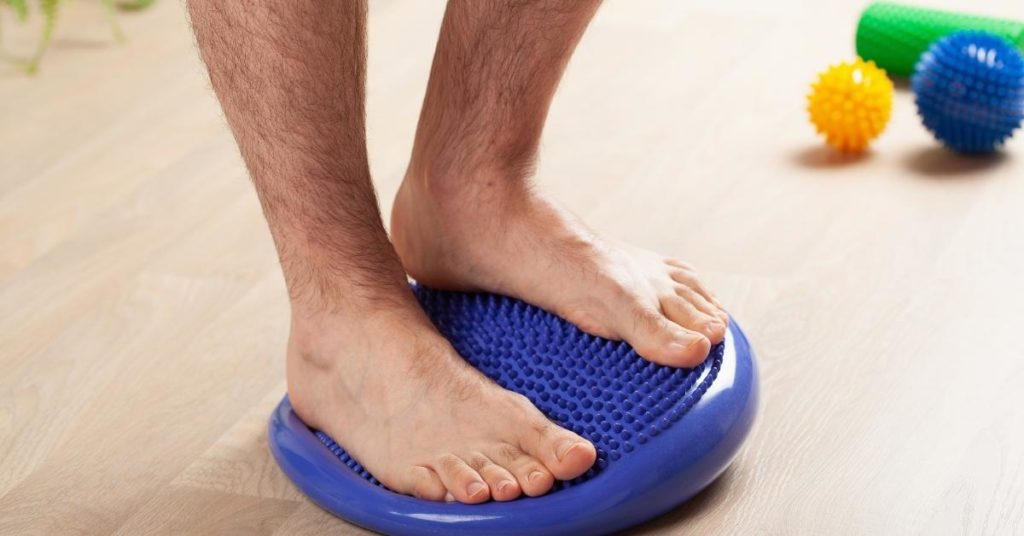Balance Training Tips

The average person walks between 6,000 and 8,000 steps a day with each step absorbing two-to-three times their body weight — depending on your activity.
Let’s face it — being sure-footed at any age can be a challenge, but you can take control by incorporating exercises to improve your balance and build strength in the intrinsic foot muscles.
Dr. Benno M. Nigg, professor emeritus of biomechanics at the University of Calgary, advocates the bottom-up approach, which focuses on increasing the strength of the small muscles crossing the ankle joint.
“Everything starts with the base,” says Nigg. “If you have weak ankle joints, you’re unstable at the base. If you’re unstable at the base, that has an effect up the body, and there’s evidence this contributes to injuries.”
Nigg thinks we should start thinking laterally. “Train the foot and ankle joints in all directions. Consider if you were building a skyscraper and you need to reinforce its stability. Where do you start? The bottom.”
Toronto’s Nsuani Baffoe, personal trainer and strength coach at Ferris360, agrees that having a strong foot core is integral to his client’s training regime. “Our feet respond to sensations, keeping us aware of our surroundings and footing. This awareness helps in our stability and balance. In fact, there are over 7,000 nerve endings in each foot, including 26 bones, 33 joints, and more than 100 tendons, muscles and ligaments. Sometimes, we forget that our feet are a direct link to that mind-body connection, signaling if we are walking on a flat or uneven surface, keeping us upright, etc. The good news is there are some easy exercises we can do to work on our foot core.”
So, where do you start?
First, balance is not just a senior moment. Dr. Clarfield at Toronto’s Cleveland Clinic says it’s never too late to improve your balance. “Start focusing on those tiny muscles in your foot and ankle as these are the muscles that allow us to react quickly and provide stability in our day-to-day activity. Work up to balance exercises to improve stability and balance. If the mechanics are not finely tuned, including flexibility and strength, it can lead to stress and issues with your knees, hips, and lower back.”
“The key is working in all directions, including both dynamic and isometric exercises,” says Nsuani. “Focus on building flexibility and strength and make sure the movements are slow and controlled.” Many of these exercises can be done in the comfort of your own home, even before you get out of bed.
Here are a few suggestions.
Lying in bed
1. Straighten your legs and gently point your toes and hold; then pull your toes toward your shin and hold. The movement should rotate your ankle and provide a slight tug on your calf muscles.
2. In the same position, perform ankle circles in both directions; imagine your big toe is a crayon and you’re drawing circles. Repeat 3 sets of 10 of each movement in both directions.
Standing at a counter or while brushing your teeth
1. Barefoot, stand with your fingers on a counter or windowsill, slowly raise your heels off the floor to stand on your toes. Hold for 4 seconds, then slowly lower your heels to the ground and rest.
Repeat 3 sets of 10.
As your strength and balance improve, take your fingers off the counter or progress to one foot only.
2. Every morning and evening, while brushing your teeth, stand on one leg, barefoot, and move up and down about 5-8 cm by bending the knee. When you’re stronger, add a cushion, so your stance is a bit unstable.
50 repetitions on each side.
During screen time
1. Press your foot towards a resistance (wall, table, chair, your other foot or a resistance band).
The presses should occur in all directions.
2. Stretch a hand towel in front of you and place your bare foot on the end of the towel nearest you.
Keeping your heel on the floor, curl your toes to bunch up the towel and drag it towards you.
Continue until you’ve bunched up the entire towel.
Do this a few times and repeat with the other foot.
3. Massage a tennis ball under your foot and roll it back and forth.
And when you’re ready, Louis Stack of Fitterfirst suggests a Balance board as part of your daily routine.
“With excellent heads-up posture, perform 10 two-legged half squats,” suggests Stack. “Your body’s effort to maintain balance will produce reactive movements through the sagittal, frontal, and transverse planes. Try to limit the times the edge of the board touches the ground, the fewer the better. Then try controlled travel from front to back, side to side then sweeping circles to expose the ankles to full range of motion.”
So, whether you’re young or old, if you want to be stable in your movement, embrace the bottom-up approach and strengthen those intrinsic foot muscles, and by doing that, things fall into place.
Before starting any exercise program, it’s always best to seek the advice of your medical professional.
Social Media Links:
https://my.clevelandclinic.org/canada
https://twitter.com/clecliniccanada
